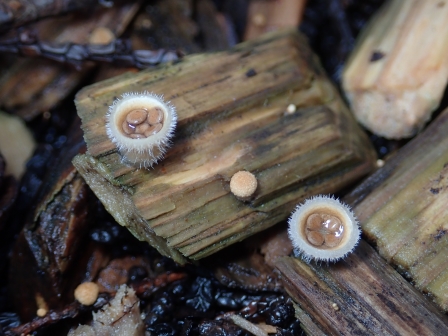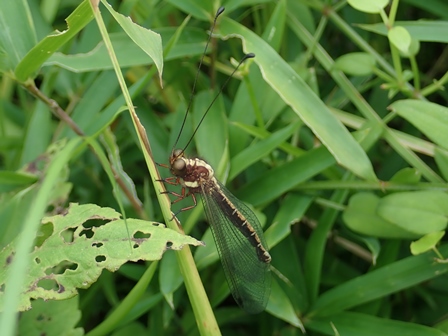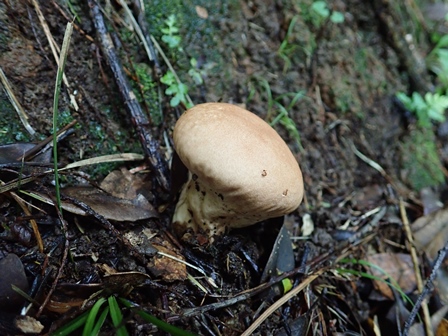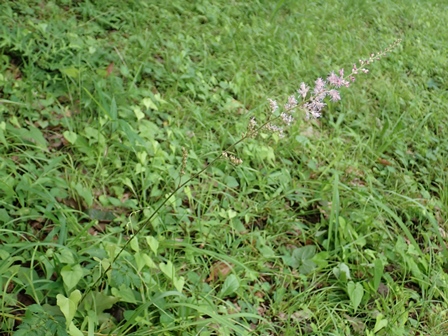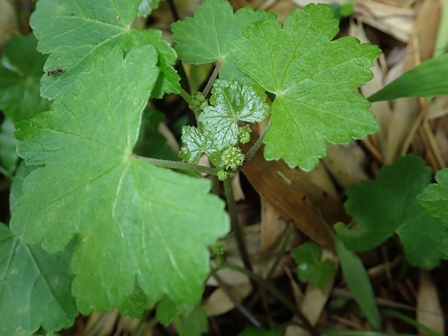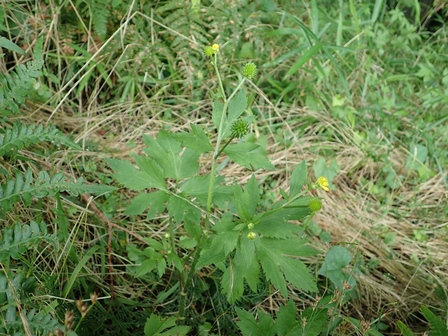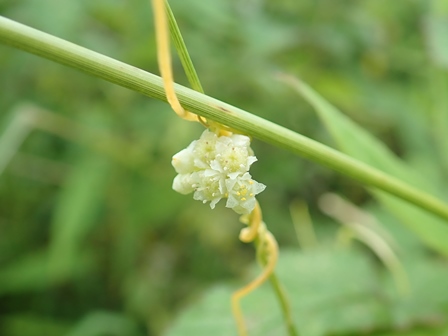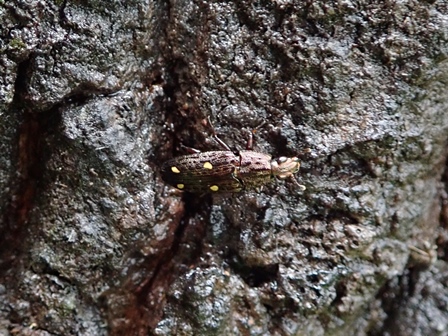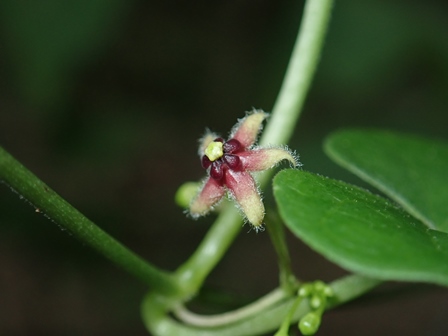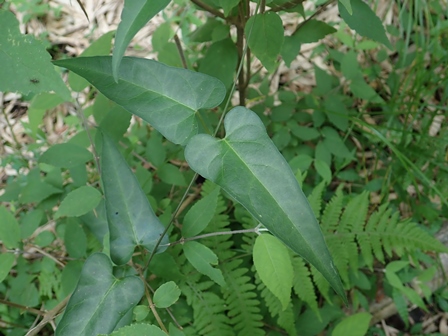フィールド日記
2020年07月
2020.07.31
コチャダイゴケ
林道のウッドチップの上にコチャダイゴケが発生していました。一見するとキノコとは思えないユニークな形をしています。茶碗のような形で、中には胞子がつまった粒が入っています。雨滴が当たると中の粒が弾き出されて、胞子を飛ばす仕組みになっています。
I found these mushrooms called "kochadaigoke(コチャダイゴケ)" on wood chips on a forest road. They have unique shapes as you might not consider them mushrooms at a glance. They look like cups and they have particles filled with spores in the cups. Rain drops flick off the particles and the spores spread outside.
2020.07.28
ツノトンボ
ススキ野原にツノトンボがいました。名前は長い触覚とトンボのような見た目のからだに由来しています。トンボと名前がついていますが、トンボよりもウスバカゲロウに近い仲間です。飛び方もトンボに比べるとぎこちなく、バサバサという感じで飛びます。
I found this "tsunotonbo(ツノトンボ)" in the Japannese grass field. The name "tsunotonbo" comes from its long antennae and its body that looks like a dragonfly. Although it has "tonbo(トンボ)" in its name, which means "dragonfly", it does not belong to a group of dragonflies but belongs to a group of antlions. Tsunotonbo fly loudly and stiffly compared to dragonflies.
2020.07.24
ノウタケ
雨が続き、キャンパス内では様々なキノコが見られます。聖心坂の斜面にノウタケが生えていました。和名は、成熟するにつれて表面にしわが寄ってきて、脳のような見た目になることが由来です。中が白い幼菌のうちは食用になるようです。
2020.07.21
チダケサシ
駐車場の近くにチダケサシが咲いていました。夏に、草原や湿地に見られる花です。和名は、長い茎に、同じく夏に見られるチチタケと呼ばれるキノコを刺して持ち帰ったことに由来すると言われています。
"チダケサシ(chidakesashi)" is in bloom near the parking lot. They live in grasslands and wetlands and bloom in summer. The name "chidakesashi" comes from "chichitake"(a kind of mashrooms) and "sashi"(to skewer). It is said that people in the past pick up "chichitake" mashrooms and skewered them with a long stem of "chidakesashi" to bring them home. That is why this flower is called “chidakesashi”.
2020.07.17
オオバチドメ
竹林の林床でオオバチドメが咲いていました。和名はチドメグサの仲間で一番葉が大きいことが由来です。チドメグサは血止草の意味で、葉の汁を傷口につけると血が止まることから名づけられました。他の仲間が空き地や野原などで見られるのに対し、本種は山地の湿った林床で見られます。
"オオバチドメ(oobachidome)" is in bloom on the bamboo forest floor. The name means that they have the largest leaves in the group of "チドメグサ(chidomegusa)" plant. "チドメグサ(chidomegusa)" is written like this "血止草" in kanji and it means "stop the bleeding". People used to put the sap from the leaves on their wounds to stop the bleeding. That’s why they are called "チドメグサ(chidomegusa)". The other species of this group lives on road sides or in fields but this one lives on moist forest floors in mountains.
2020.07.14
ケキツネノボタン
ヒノキ林の林縁でケキツネノボタンが咲いていました。葉が少しボタンの葉に似ていますが、花は全く似ていません。和名のキツネノボタンは、葉がボタンに似ているにもかかわらず花は全く異なるという事実が、キツネが人を化かすイメージと重ねられて名付けられたと考えられます。
I found "ケキツネノボタン(kekitsunenobotan)" blooming on the edge of the Japanese cypress woodland. Their leaves looks a little similar to "ボタン(botan)" plants but their flowers are totally different. "キツネ" in the name means "fox". And, in Japan, fox has an image that they trick people. It is because they have leaves that resemble the "ボタン(botan)" plant but their flowers don't resemble. This reminds people of a fox's image that foxes trick people. That's why they are called "ケキツネノボタン(kekitsunenobotan)".
2020.07.10
アメリカネナシカズラ
下の写真のように、ススキ野原で黄色い麺のようなものが、植物にからみついているのが見られました。アメリカネナシカズラです。北アメリカ原産の帰化植物で、葉緑体はなく寄生根によって他の植物に寄生して生きています。
和名のネナシカズラは根無し葛の意味で、他の植物から栄養や水分を吸収するようになると、自身の根は枯れてしまうことに由来しています。数年前から近くを流れる黄瀬川の河原で繁茂しているのを確認していましたが、いつの間にかススキ野原にも侵入していました。
Like in the first picture, you can see yellow noodle-like stuff in the Japanese pampas grass field. It's the "アメリカネナシカズラ(amerikanenashikazura)". They came from North America. They don't have chloroplasts and they live on other plants.
"ネナシカズラ(nenashikazura)" in the name is written like this "根無し葛" in kanji and it means "vine plant having no roots". As they grow, they spread their parasitic roots on other plants and their own roots connected to the ground die. That's why they are called "ネナシカズラ(nenashikazura)". From a few years ago, I have noticed that they have flourished on the river sides of the Kise river near here. However, I don't know when they came to this Japanese pampas grass field.
2020.07.08
6月の野鳥の調査
2020年6月度の調査で確認された野鳥は下記の通りです。
2020.07.07
ムナビロオオキスイ
クヌギの樹液にムナビロオオキスイが来ていました。和名のキスイは木吸いの意味で、樹液に集まってくることを表していると思われます。体は銅色の金属光沢があり綺麗です。ヨツボシオオキスイととても良く似ていますが、上翅の模様で見分けることができます。
I found this "ムナビロオオキスイ(munabiroookisui)" around the Japanese oak tree sap. "キスイ(kisui)" in the name is written like this "木吸い" in kanji and means "suck trees". They aggregate on tree saps. Its body is a bronze metallic color and beautiful. There are similar species called "ヨツボシオオキスイ(yotsuboshiookisui)". You can identify them by the patterns on their wings.
2020.07.03
オオカモメヅル
ヒノキ林の林縁でオオカモメヅルを見つけました。薄紫色の花冠の内側には、濃い紫色の副花冠と呼ばれる構造があり、よく目立ちます。
和名は、つる性の植物であることと、葉が翼を広げたカモメに見えることに由来しています。
I found "オオカモメヅル(ookammeduru)" on the edge of the Japanese cypress woodland. They have conspicuous dark-purple paracorollas inside light-purple corollas.
"カモメ(kamome)" and "ヅル(duru)" in its name means a "seagull" bird and a "vine plant" respectively. So the name derives from the two main features that it's a vine plant and their leaves looks like seagulls with opened wings.
- 1 / 1


